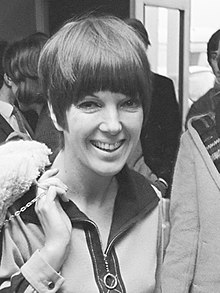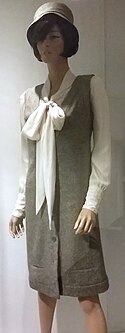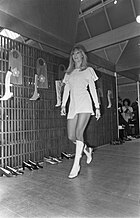This is an old revision of this page, as edited by 78.86.132.66 (talk) at 12:48, 13 April 2023. The present address (URL) is a permanent link to this revision, which may differ significantly from the current revision.
Revision as of 12:48, 13 April 2023 by 78.86.132.66 (talk)(diff) ← Previous revision | Latest revision (diff) | Newer revision → (diff) British fashion designer (1930–2023)| This article is currently being heavily edited because its subject has recently died. Information about their death and related events may change significantly and initial news reports may be unreliable. The most recent updates to this article may not reflect the most current information. Please feel free to improve this article (but edits without reliable references may be removed) or discuss changes on the talk page. (Learn how and when to remove this message) |
| DameMary QuantCH DBE FCSD RDI | |
|---|---|
 Quant in 1966 Quant in 1966 | |
| Born | Barbara Mary Quant (1930-02-11)11 February 1930 Blackheath, London, England |
| Died | 13 April 2023(2023-04-13) (aged 93) Surrey, England |
| Other names | Barbara Mary Plunket Greene |
| Education | Goldsmiths College |
| Label | Mary Quant |
| Spouse |
Alexander Plunket Greene
(m. 1957; died 1990) |
| Children | 1 |
| Awards | CH, DBE, FCSD, RDI |
Dame Barbara Mary Plunket Quant CH DBE FCSD RDI (11 February 1930 – 13 April 2023) was a British fashion designer and fashion icon. She became an instrumental figure in the 1960s London-based Mod and youth fashion movements. She was one of the designers who took credit for the miniskirt and hotpants. Ernestine Carter wrote: "It is given to a fortunate few to be born at the right time, in the right place, with the right talents. In recent fashion there are three: Chanel, Dior, and Mary Quant."
Early life
Quant was born on 11 February 1930, in Blackheath, London, the daughter of Welsh teachers. Her parents, Jack and Mildred Quant, were both from mining families; however, they had been awarded scholarships to grammar school and had both attained first-class degrees at Cardiff University before they moved to London to work as school teachers.
Quant went to Blackheath High School. For college, her desire had been to study fashion; however, her parents dissuaded her from that course of study, and she instead studied illustration and art education at Goldsmiths College for which she received a degree in 1953. In pursuit of her love for fashion, after finishing her degree, she apprenticed with Erik, a high-end Mayfair milliner on Brook Street next door to Claridge's hotel.
Fashion career

Quant initially sold clothing sourced from wholesalers in her new boutique. The bolder and more unique pieces in her collection started garnering more attention from media like Harper's Bazaar, and an American manufacturer purchased some of her dress designs. Because of this attention and her personal love for these bolder styles, she decided to take designs into her own hands. Initially working solo, she was soon employing a handful of sewing-machine operators; by 1966 she was working with a total of 18 manufacturers. A self-taught designer inspired by the culture-forward "Chelsea Set" of artists and socialites, Quant's designs were riskier and more unique than standard styles of the time. Quant's designs revolutionized fashion from the utilitarian wartime standard of the late 40s to the energy of the 50s and 60s' cultural shifts. She stocked her own original items in an array of colours and patterns, such as colourful tights.
Quant's impact did not just come from her unique designs; in her boutique, Bazaar, she created a special environment, including music, drinks, and long hours that appealed to young adults. This environment was unique for the industry, as it differentiated from the stale department stores and inaccessible high-end designer store environments that had a hold of the fashion market. Her window displays with models in quirky poses brought a lot of attention to her boutique, where people would often stop to stare at the eccentric displays. She states, "Within 10 days, we hardly had a piece of the original merchandise left."
For a while in the late 1950s and early 1960s, Quant was one of only two London-based high-end designers consistently offering youthful clothes for young people. The other was Kiki Byrne, who opened her boutique on the King's Road in direct competition with Quant.
In 1966, Quant was named one of the "fashion revolutionaries" in New York by Women's Wear Daily, alongside Edie Sedgwick, Tiger Morse, Pierre Cardin, Paco Rabanne, Rudi Gernreich, André Courrèges, Emanuel Ungaro, Yves Saint Laurent, and Baby Jane Holzer.
Quant and the miniskirt

The miniskirt, described as one of the defining fashions of the 1960s, is one of the garments most widely associated with Quant. While she is often cited as the inventor of the style, this claim has been challenged by others. Marit Allen, a contemporary fashion journalist and editor of the influential "Young Ideas" pages for UK Vogue, firmly stated that another British fashion designer, John Bates, rather than Quant or André Courrèges, was the original creator of the miniskirt. Others credit Courrèges with the invention of the style. However, skirts had been getting shorter since the 1950s—a development Quant considered practical and liberating, allowing women the ability to run for a bus.

Quant later said: "It was the girls on the King's Road who invented the miniskirt. I was making easy, youthful, simple clothes, in which you could move, in which you could run and jump and we would make them the length the customer wanted. I wore them very short and the customers would say, 'Shorter, shorter.'" She gave the miniskirt its name, after her favourite make of car, the Mini, and said of its wearers: "they are curiously feminine, but their femininity lies in their attitude rather than in their appearance ... She enjoys being noticed, but wittily. She is lively—positive—opinionated." The fashion model Twiggy would popularise the miniskirt abroad.
In addition to the miniskirt, Quant is often credited with inventing the coloured and patterned tights that tended to accompany the garment, although their creation is also attributed to the Spanish couturier Cristóbal Balenciaga, who offered harlequin-patterned tights in 1962, or to John Bates.
Later career
In the late 1960s, Quant offered short shorts that were the forerunner of hotpants and became a British fashion icon. In 1967 she designed berets in twelve colours for British headwear company Kangol. Quant's berets, featuring her daisy logo, are in her collection at the Victoria and Albert Museum. Through the 1970s and 1980s she concentrated on household goods and make-up rather than just her clothing lines, including the duvet, which she claims to have invented.

 Classic Mary Quant dresses exhibited at the 2019 Goodwood Revival motor racing festival in England
Classic Mary Quant dresses exhibited at the 2019 Goodwood Revival motor racing festival in England
In 1988, Quant designed the interior of the Mini (1000) Designer (originally dubbed the Mini Quant, the name was changed when popularity charts were set against having Quant's name on the car). It featured black-and-white striped seats with red trimming. The seatbelts were red, and the driving and passenger seats had Quant's signature on the upper left quadrant. The steering-wheel had Quant's signature daisy, and the bonnet badge had "Mary Quant" written over the signature name. The headlight housings, wheel arches, door handles and bumpers were all "nimbus grey", rather than the more common chrome or black finishes. Two thousand were released in the UK on 15 June 1988, and a number were also released on to foreign markets; however, the numbers for these are hard to come by. The special edition Mini came in two body colours, jet black and diamond white.
In 2000, she resigned as director of Mary Quant Ltd, her cosmetics company, after a Japanese buy-out. There are more than 200 Mary Quant Colour shops in Japan.
Personal life and death
Quant met her future husband and business partner, Alexander Plunket Greene, grandson of the Irish singer Harry Plunket Greene, in 1953. They were married from 1957 until his death in 1990, and had a son, Orlando, born in 1969.
Quant died at her home in Surrey on 13 April 2023, at the age of 93.
Honours and recognition
—Jenny Lister, curator of textiles and fashion at the V&A."She was the godmother of the youth movement in fashion, the first to realise that how women dressed needed to change."
In 1963, Quant was the first winner of the Dress of the Year award. In 1966 she was appointed Officer of the Order of the British Empire (OBE) for her outstanding contribution to the fashion industry. She arrived at Buckingham Palace to accept the award in a cream wool jersey minidress with blue facings. In 1990 she won the Hall of Fame Award of the British Fashion Council. She was appointed Dame Commander of the Order of the British Empire (DBE) in the 2015 New Year Honours for services to British fashion. She was appointed Member of the Order of the Companions of Honour (CH) in the 2023 New Year Honours for services to fashion.
Quant received an honorary doctorate from Heriot-Watt University in 2006. In 2009, the miniskirt designed by Quant was selected by the Royal Mail for their "British Design Classics" commemorative postage stamp issue. In 2012, she was among the British cultural icons selected by artist Sir Peter Blake to appear in a new version of his most famous artwork – the Beatles' Sgt. Pepper's Lonely Hearts Club Band album cover – to celebrate the British cultural figures of his life.
Quant was a fellow of the Chartered Society of Designers, and winner of the Minerva Medal, the society's highest award.
Books by Quant
- 1966: Quant by Quant — her first autobiography
- 1984: Colour by Quant
- 1986: Quant on Make-up
- 1999: Classic Make-up and Beauty Book
- 2011: Mary Quant: Autobiography — her second autobiography
Trivia
| This section contains a list of miscellaneous information. Please relocate any relevant information into other sections or articles. (January 2023) |
- In the 1966 Donovan song "Sunny South Kensington", Quant and Jean-Paul Belmondo's drug use/abuse is immortalised in the lyric "Jean-Paul Belmondo and-a Mary Quant got stoned, to say the least".
- French musician Laurent Voulzy dedicated a song to Quant on his 2001 album Avril
- Quant is referenced in the musical number "This Is What We Want" in the 2014 stage musical Made in Dagenham, based on the 2010 film of the same name.
See also
- Daisy, doll designed by Quant
Notes
- The Mary Quant exhibition at the Victoria and Albert Museum in 2019-20 stated her year of birth as 1930, and that she became a student at Goldsmiths College around 1950.
References
- Quant profile, thesteepletimes.com. Retrieved 7 May 2015.
- ^ Ho, Karen (3 July 2012). "The Brit List: Five Great British Fashion Designers". BBC America website. BBC. Retrieved 16 October 2012.
- "New Year Honours: Designer Mary Quant among Welsh recipients". BBC News. 30 December 2014. Retrieved 9 January 2015.
- Do Je-Hae (10 October 2012). "Mary Quant, British Fashion Icon". The Korea Times. Retrieved 16 October 2012.
- McKinnell, Joyce (1964). Beauty. Harper Collins. p. 93. ISBN 9780007295586.
- "1966 trouser suit by Mary Quant". Victoria and Albert Museum. Retrieved 12 July 2012.
- Barbara Burman accessed 12 July 2012 "Carter, Ernestine Marie (1906–1983)" profile, Oxford Dictionary of National Biography, Oxford University Press, 2004, oxforddnb.com. Retrieved 31 December 2014.
- Connikie, Yvonne (2006). Fashion of a Decade. Infobase Publishing. p. 17. ISBN 9781438118925.
- General Register Office. "Entry Information: Births Mar 1930 Quant Barbara M". FreeBMD. ONS. Retrieved 20 February 2020.
- General Register Office of England and Wales, Births, March quarter 1930, Woolwich, Vol 1d, p. 1570.
- ^ Polan, Brenda; Tredre, Roger (2009). The Great Fashion Designer. New York: Berg. pp. 103–04. ISBN 978-1-84788-228-8.
- ^ "Mary Quant". Victoria and Albert Museum website. Victoria and Albert Museum. 2011. Archived from the original on 14 September 2009. Retrieved 24 February 2011.
- ^ Armstrong, Lisa (17 February 2012). "Mary Quant: 'You have to work at staying slim – but it's worth it'". The Telegraph. Retrieved 17 October 2013.
- DelaHaye, Amy (2010). Steele, Valerie (ed.). The Berg Companion to Fashion. Oxford: Berg. pp. 586–588. ISBN 978-1847885630.
- ^ "Mary Quant: How She Fought for Women's Rights With Colourful Tights". Bloom magazine. Retrieved 2 October 2022.
- Nicolson, Juliet (11 February 2020). "Mary Quant: Life, love and liberty". Harper's BAZAAR. Retrieved 7 December 2021.
- Denza, Vanessa. "Interview with Vanessa Denza MBE". Victoria and Albert Museum. Retrieved 2 June 2014.
- Waddell, Gavin (2004). How fashion works: couture, ready-to-wear, and mass production (Online-Ausg. ed.). Oxford, UK: Blackwell Science. p. 130. ISBN 9781118814994.
- O'Byrne, Robert (2009). Style city: how London became a fashion capital. London: Frances Lincoln. p. 14. ISBN 9780711228955.
- "Revolution In Fashion Reaction In New York: These Were The Revolutionaries". Women’s Wear Daily. Vol. 112, no. 74. 14 April 1966. pp. 4–5.
- Horton, Ros; Simmons, Sally (2007). Women Who Changed the World. p. 170. ISBN 9781847240262.
- "Garments worn by Marit Allen". Victoria and Albert Museum. Retrieved 12 July 2012.
- ^ Cartner-Morley, Jess (2 December 2000). "Chelsea girl who instigated a new era". The Guardian. Retrieved 12 July 2012.
- Miles, Barry (2009). The British Invasion: The Music, the Times, the Era. Sterling Publishing Company, Inc. p. 194. ISBN 9781402769764.
- Miles, Barry (2009). The British Invasion: The Music, the Times, the Era. Sterling Publishing Company, Inc. p. 203. ISBN 9781402769764.
- Seebohm, Caroline (19 July 1971). "English Girls in New York: They Don't Go Home Again". New York. p. 34. Retrieved 6 January 2015.
- ^ "Mary Quant: The designer who launched a fashion revolution". The Courier. Retrieved 2 October 2022.
- Carter, Ernestine (1977). The changing world of fashion: 1900 to the present. London: Weidenfeld and Nicolson. p. 213. ISBN 9780297773498.
- Lester, Richard, John Bates: Fashion Designer, London, 2008.
- "Mary Quant profile". BBC website. BBC. November 2008. Retrieved 9 January 2011.
Quant was responsible for hot pants, the Lolita look, the slip dress, PVC raincoats, smoky eyes and sleek bob haircuts, but it was make-up that eventually made her company the most money.
- Hillary Alexander (9 January 2009). "Fashion designer Mary Quant to have design included on Royal Mail stamps". The Daily Telegraph. London, UK. Retrieved 9 July 2020.
Apart from the mini, Quant is credited with popularising white "go-go" boots, patterned tights, brightly-coloured "Paintbox" make-up, the micro-mini skirt, plastic raincoats, the "wet look", and hot-pants, which she designed in 1966, the year she received an OBE from the Queen for her services to the fashion industry.
- Milford-Cottam, Daniel (2020). Fashion in the 1960s. Shire Publications. pp. 16–17. ISBN 9781784424084.
Some of the shortest were provided by Bates and Quant, who tempered the briefness by offering matching tights or shorts to wear underneath. These shorts, effectively modesty knickers foreshadowed the hotpants of the early 1970s.
- ^ "Berets: Mary Quant (designer)". V&A collections. Retrieved 2 October 2022.
- ^ Gillan, Audrey (2 December 2000). "Mary Quant quits fashion empire". The Guardian. Retrieved 12 July 2012.
- "Fashion designer Mary Quant dies aged 93". Sky News. Retrieved 13 April 2023.
- "O.B.E. Dress by Mary Quant". Victoria and Albert Museum. Retrieved 12 July 2012.
- "No. 61092". The London Gazette (Supplement). 31 December 2014. p. N8.
- 2015 New Year Honours List Archived 2 January 2015 at the Wayback Machine, Government of the United Kingdom. Retrieved 31 December 2014.
- "No. 63918". The London Gazette (Supplement). 31 December 2022. p. N6.
- "New Year Honours 2023: Brian May and Lionesses on list". BBC News. 30 December 2022. Retrieved 30 December 2022.
- "Annual Review 2006 : People, Honours and Awards". www1.hw.ac.uk. Archived from the original on 13 April 2016. Retrieved 30 March 2016.
- "In pictures: Royal Mail's British design classic stamps". The Guardian. 13 January 2009. Retrieved 30 September 2022.
- "New faces on Sgt Pepper album cover for artist Peter Blake's 80th birthday". The Guardian. 2016.
- "These were the days that shook the world". The Guardian. 5 October 2016.
- Quant, Mary (2012). Mary Quant: Autobiography. London: Headline. ISBN 978-0-7553-6017-8.
- "Sunny South Kensington", The Little Black Songbook Of Donovan, Wise Publications, 2013, ISBN 978-1-78305-101-4, p. 136.
- EPIC 5-10098, "Mellow Yellow"/"Sunny South Kensington" 45 rpm single, 1966.
- "Sophie Isaacs & The "Made in Dagenham" Female Cast – This Is What We Want Lyrics". Retrieved 16 November 2019.
Further reading
- Sandbrook, Dominic. White Heat: A history of Britain in the swinging sixties (Abacus, 2015) pp. 217–37.
External links
- Mary Quant at FMD

- Mary Quant at IMDb

- Mary Quant at the Victoria and Albert Museum, London Accessed 3 June 2010.
- Mary Quant – Miniskirt – Icons of England
- Official website of Mary Quant Cosmetics
- Recent deaths
- 1930 births
- 2023 deaths
- Alumni of Goldsmiths, University of London
- British fashion designers
- Welsh fashion designers
- Members of the Order of the Companions of Honour
- Dames Commander of the Order of the British Empire
- Chartered designers
- People from Blackheath, London
- People educated at Blackheath High School
- British women artists
- Welsh women artists
- British women fashion designers
- English people of Welsh descent